|
|
Twin Rivers Hatchery celebrates,
now open for business |
|
October 11, 2014 |
The ribbon has been cut on the Kootenai Tribe's
Twin Rivers Sturgeon and Burbot Hatchery.
In terms of fish hatcheries, this new facility
at the confluence of the Moyie and Kootenai
Rivers can only be described as fabulous. And,
in addition, "It's the only one of its kind in
the world," per Tribal Chair Gary Aitken, Jr.
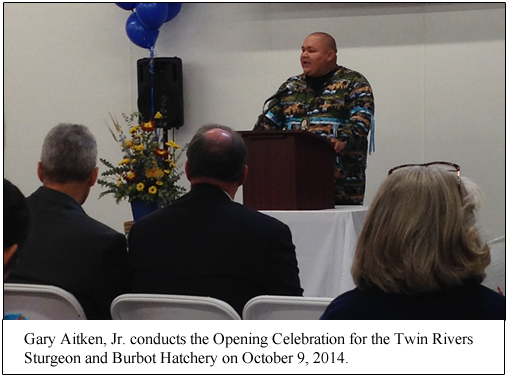
Yesterday was the opening celebration for the
new hatchery. In attendance were both United
States senators for Idaho, the Kootenai Tribal
Council, all Boundary County commissioners,
representatives and administrators from the
Bonneville Power Administration, the U.S. Fish
and Wildlife Service, Idaho Fish and Game, other
agencies, and hundreds--perhaps 300--area
residents and visitors.
The festive event to open the sparkling new
hatchery featured brief speeches by various
officials, drumming by the Kootenai Tribe's
Sukni Singers, a commemorative plaque presented
to the Tribe from Idaho Fish and Game, great
refreshments, and tours of the new hatchery
tanks and equipment. Videos illustrating the
processes of raising sturgeon and burbot played
on screens scattered around the building.
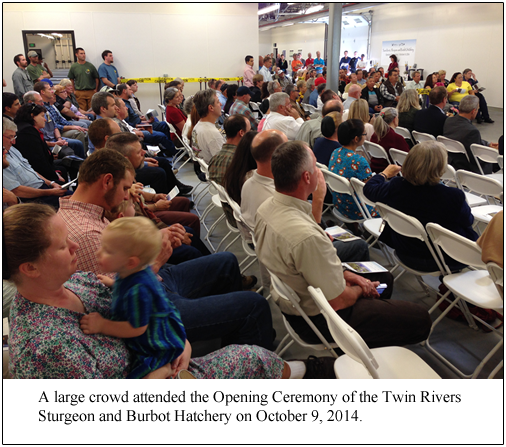
The celebration ceremonies were conducted by Mr.
Aitken, who recalled the remarkable progress
made in the development of the hatchery program
over the years. He mentioned that the site near
the Reservation where the Tribe's original,
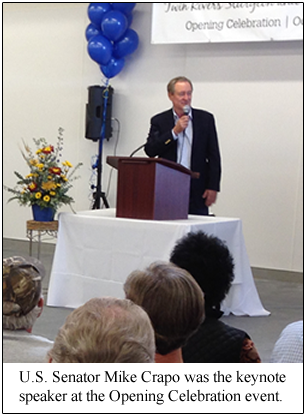 older
hatchery now sits used to be a horse pasture
where he would play as a child. The first
hatchery facility there started out as rather
primitive and small, had several upgrades and
renovations over the years, eventually leading
to the concept and realization of the new,
large, state-of-the-art hatchery at Twin Rivers. older
hatchery now sits used to be a horse pasture
where he would play as a child. The first
hatchery facility there started out as rather
primitive and small, had several upgrades and
renovations over the years, eventually leading
to the concept and realization of the new,
large, state-of-the-art hatchery at Twin Rivers.
"So many people and organizations have been a
part of this wonderful journey, and we can't
thank them enough," Mr. Aitken said.
A blessing and prayer for the new facility were
invoked by Velma Bahe, a member of the Tribal
Council.
This was followed by U.S. Senator Mike Crapo,
who gave the keynote address. Senator Crapo
lauded the cooperation and collaboration of all
the many partners and stakeholders in the
project, noting how this has helped the project
succeed while at the same time promoting
economic growth. He stated he has many times, in
other meetings and projects with which he has
been involved as a U.S. Senator, used this
Boundary County / Kootenai Valley project "as an
example all over this country of how consensus
can be used."
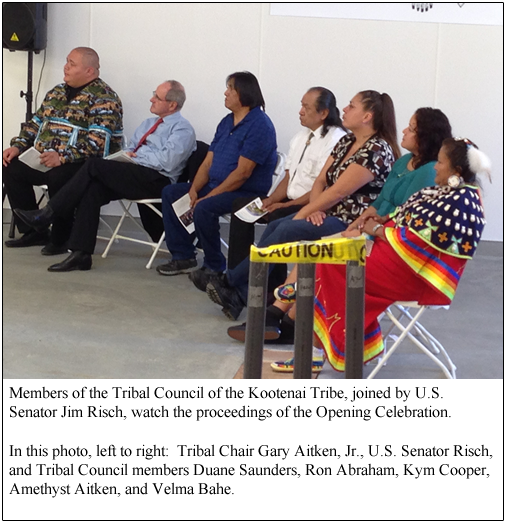
He recounted also how privileged he felt, as he
has worked closely with the tribe over the
years, to actually help out with some of the
day-to-day work at the old hatchery. He has even
gone out on the river with hatchery staff to
help release young hatchery sturgeon into the
Kootenai.
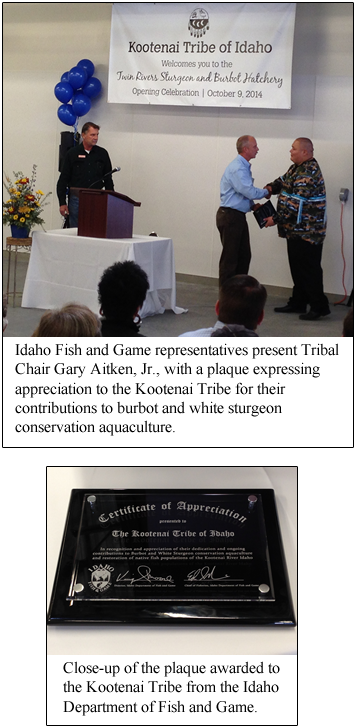 Boundary County Commission chairman Dan Dinning
also lauded how progress on this project was
made through collaborative efforts. Boundary County Commission chairman Dan Dinning
also lauded how progress on this project was
made through collaborative efforts.
Sue
Ireland, Tribal Fish and Wildlife Department
Director, mentioned she set out to make a list
of everyone who has helped out on the project.
"I ran out of paper," she said.
Other speakers at the event were U.S. Senator
James E. Risch, and Greg Delwiche, the Deputy
Administrator of Bonneville Power
Administration. Most of the funding for
operation of the aquaculture program, including
upgrades of the already-existing facility and
the new Twin Rivers site, is provided by the
Bonneville Power Administration.
The populations of white sturgeon and burbot in
the Kootenai River constituted a valuable
social, economic, and sustenance fishery for
many generations for the Kootenai Tribe and
later for others who settled in the area. For a
variety of reasons, these fish populations went
into marked decline beginning around the middle
of the last century.
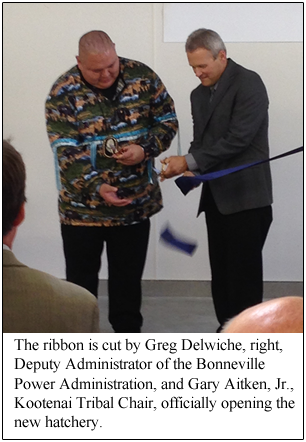
The Kootenai Tribe began their original hatchery
program in 1989, with original
efforts directed toward conservation of the
Kootenai River's white sturgeon as the sturgeon
numbers collapsed in the decades previous. The
Kootenai River sturgeon were eventually
designated as "Endangered" in 1994, under the
provisions of the Endangered Species Act. Later,
the tribe took on the aquaculture of burbot, a
freshwater cod that had previously been present
in large numbers in the river. At one point it
was estimated the Kootenai River burbot had
dwindled to 50 fish. They could not be listed
under the Endangered Species Act as they were
not considered to constitute a "distinct
population segment," although the burbot were
recognized as being functionally extinct.
The aquaculture of burbot had not previously
been fully done anywhere or anytime previously.
There were no instructions or how-to for that
particular species. The Tribe, along with their
multiple collaborative partners, launched into
researching and developing the myriad protocols,
best practices, and details of raising burbot.
Through
research, and using known and innovative new
methods determined through experimentation at
the Kootenai Tribe's fish hatchery and
elsewhere, techniques were developed involving
burbot spawning, egg incubation, larval and
juvenile rearing, and other important facets of
raising burbot. Also, studies of disease
susceptibility of burbots were done in order to
best prepare for eventual stocking efforts back
into the Kootenai River.
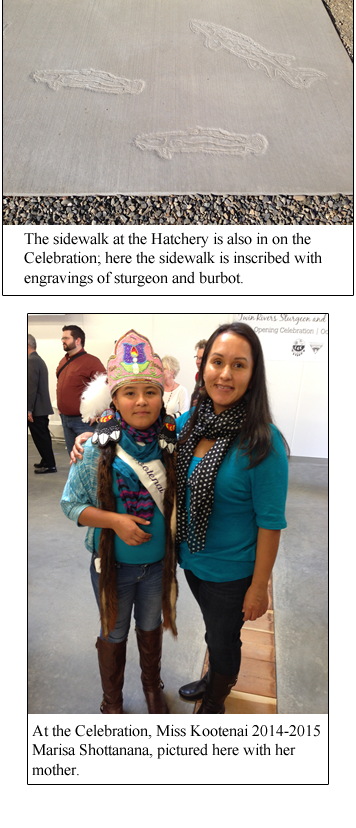
Now, the book has been written on the
aquaculture of burbot, and it was written right
here, as the Kootenai Tribe collaborated in
their work with U.S. Fish and
Wildlife Service, the Kootenai Valley Resource
Initiative, the Idaho Department of Fish and
Game, the University of Idaho's Aquaculture
Research Institute, the Bonneville Power
Administration, and the British Columbia
Ministry of Environment, along with other
stakeholders.
And now the world's premier sturgeon and burbot
hatchery and aquaculture program is found in
Boundary County, at the confluence of the Moyie
and Kootenai Rivers, at the Twin Rivers Sturgeon
and Burbot Hatchery, and is open for business.
To date, thousands of sturgeon and thousands of
burbot have been raised in the Tribe's hatchery
program and released into the Kootenai River and
its tributaries.
The large, main hatchery building, with a
footprint of approximately 40,000 square
feet, dominates the site at Twin Rivers. This
building includes tanks--well over a
hundred--for the propagation, rearing, and care
of sturgeon and burbot, and also for the culture
of Artemia and rotifers which are used as live
feed for the larval fish.
The site also has water intakes on both the
Moyie and the Kootenai Rivers. It includes a
pump station, and systems for treating water to
meet requirements of the program. There is also
a shop, storage and parking areas, new
utilities, new residences for staff, and a boat
launch.
One more opportunity to see and tour the
facility is coming up. A Community Open House
will be held at the new hatchery on October 25,
with tours given from 9:00 a.m. until noon. This
may be one of the last chances for the public to
get a detailed look at the facilities up close
and in person, as once the hatchery is fully
operating, the public will not be able to enter
the sturgeon and burbot areas.
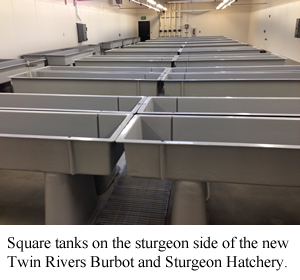
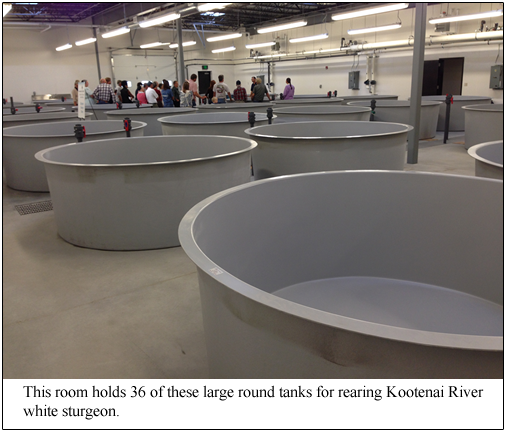
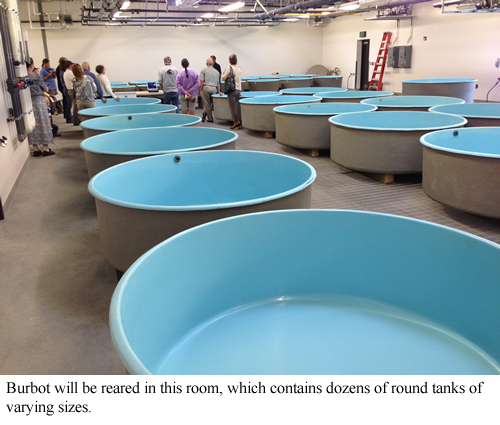
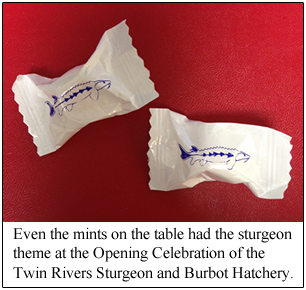
|
|
|
|
Questions or comments about this
article?
Click here to e-mail! |
|
|
|
|

